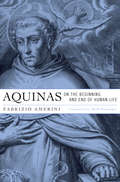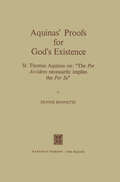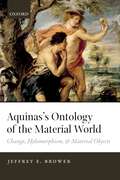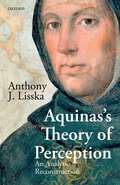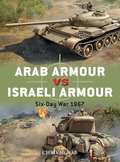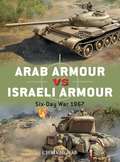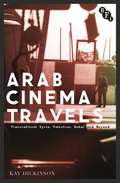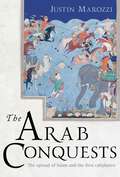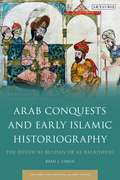- Table View
- List View
Aquinas on the Beginning and End of Human Life
by Fabrizio AmeriniThough often invoked by pro-life supporters, Thomas Aquinas in fact held that human life begins after conception, not at the moment of union. But in following the twists and turns of Aquinas’ thinking about the beginning and end of human life, Fabrizio Amerini reaches a nuanced interpretation that will unsettle both sides in the abortion debate.
Aquinas’ Proofs for God’s Existence: St. Thomas Aquinas on: “The Per Accidens Necessarily Implies the Per Se”
by D. BonnetteThe purpose of this study is to investigate the legitimacy of the principle, "The per accidens necessarily implies the per se," as it is found in the writings of St. Thomas Aquinas. Special emphasis will be placed upon the function of this principle in the proofs for God's existence. The relevance of the principle in this latter context can be seen at once when it is observed that it is the key to the solution of the well known "prob lem of infinite regress. " The investigation of the principle in question will be divided into two Parts. A preliminary examination of the function of the principle will be made in Part I: Domains Other Than That of Creature-God. The domains to be considered in this Part are those of accident-substance, change, and knowledge. Employing what is learned of the function of the principle in these areas of application, Part II: The Domain of Creature-God will analyze the role of the principle in the proofs for God's existence. This latter Part will constitute the greater portion of the book, since the domain of creatures in their relation to God is the most significant application of the principle in the writings of St. Thomas. In the course of this investigation, relevant analyses by St. Thomas' commentators - both classical and contemporary - will be considered. Finally, in light of the insights offered by St.
Aquinas's Ontology Of The Material World: Change, Hylomorphism, And Material Objects
by Jeffrey E. BrowerWhat is the nature of the material world? And how are its fundamental constituents to be described? These questions are of central concern to contemporary philosophers, and in their attempt to answer them, they have begun reconsidering traditional views about metaphysical structure, including the Aristotelian view that material objects are best described as 'hylomorphic compounds'—that is, objects composed of both matter (hyle) and form (morphe). In this major new study, Jeffrey E. Brower presents and explains the hylomorphic conception of the material world developed by Thomas Aquinas, the most influential Aristotelian of the Middle Ages. According to Brower, the key to understanding Aquinas's conception lies in his distinctive account of intrinsic change. Beginning with a novel analysis of this account, Brower systematically introduces all the elements of Aquinas's hylomorphism, showing how they apply to material objects in general and human beings in particular. The resulting picture not only sheds new light on Aquinas's ontology as a whole, but provides a wholesale alternative to the standard contemporary accounts of material objects. In addition to presenting and explaining Aquinas's views, Brower seeks wherever possible to bring them into dialogue with the best recent literature on related topics. Along the way, he highlights the contribution that Aquinas's views make to a host of contemporary metaphysical debates, including the nature of change, composition, material constitution, the ontology of stuff vs. things, the proper analysis of ordinary objects, the truthmakers for essential vs. accidental predication, and the metaphysics of property possession.
Aquinas’s Philosophical Commentary on the Ethics: A Historical Perspective (The New Synthese Historical Library #50)
by J.C. DoigIs Aquinas's Sententia libri Ethicorum an interpretation of Aristotle based on `principles of Christian ethics'? Or do we have in that work a presentation of the foundation of Aquinas's moral philosophy? Professor Doig answers these questions through an examination of the historical context within which the Sententia was composed. In Chapters 1-2, the work's role as a corrective of earlier commentaries is established. Chapter 3, by examining philosophy at Paris between 1215 and 1283, reveals that the proposal by Aquinas of a moral philosophy would have been unexceptional. Chapter 4's investigation of the principles underlying the moral theory of the Sententia makes apparent that they were regarded by Aquinas as both philosophical and Aristotelian. The date to be assigned the composition of the Sententia is studied in Chapter 5, and the conclusion is drawn, that with some probability, the Sententia is its author's final proposal of moral doctrines. The closing Chapter offers a summary of that moral philosophy against the historical background brought out earlier.
Aquinas's Philosophy of Religion
by P. O'GradyThis is an exploration and analysis of Aquinas's contribution to the philosophy of religion. It examines Aquinas's contexts, his views on philosophy and theology, as well as faith and reason. His arguments for God's existence, responses to objections against God's existence and his characterization of the nature of God are examined.
Aquinas's Theory of Perception: An Analytic Reconstruction
by Anthony J. LisskaAnthony J. Lisska presents a new analysis of Thomas Aquinas's theory of perception. While much work has been undertaken on Aquinas's texts, little has been devoted principally to his theory of perception and less still on a discussion of inner sense. The thesis of intentionality serves as the philosophical backdrop of this analysis while incorporating insights from Brentano and from recent scholarship. The principal thrust is on the importance of inner sense, a much-overlooked area of Aquinas's philosophy of mind, with special reference to the vis cogitativa. Approaching the texts of Aquinas from contemporary analytic philosophy, Lisska suggests a modest 'innate' or 'structured' interpretation for the role of this inner sense faculty. Dorothea Frede suggests that this faculty is an 'embarrassment' for Aquinas; to the contrary, the analysis offered in this book argues that were it not for the vis cogitativa, Aquinas's philosophy of mind would be an embarrassment. By means of this faculty of inner sense, Aquinas offers an account of a direct awareness of individuals of natural kinds—referred to by Aquinas as incidental objects of sense—which comprise the principal ontological categories in Aquinas's metaphysics. By using this awareness of individuals of a natural kind, Aquinas can make better sense out of the process of abstraction using the active intellect (intellectus agens). Were it not for the vis cogitativa, Aquinas would be unable to account for an awareness of the principal ontological category in his metaphysics.
Aquinas's Theory of Perception: An Analytic Reconstruction
by Anthony J. LisskaAnthony J. Lisska presents a new analysis of Thomas Aquinas's theory of perception. While much work has been undertaken on Aquinas's texts, little has been devoted principally to his theory of perception and less still on a discussion of inner sense. The thesis of intentionality serves as the philosophical backdrop of this analysis while incorporating insights from Brentano and from recent scholarship. The principal thrust is on the importance of inner sense, a much-overlooked area of Aquinas's philosophy of mind, with special reference to the vis cogitativa. Approaching the texts of Aquinas from contemporary analytic philosophy, Lisska suggests a modest 'innate' or 'structured' interpretation for the role of this inner sense faculty. Dorothea Frede suggests that this faculty is an 'embarrassment' for Aquinas; to the contrary, the analysis offered in this book argues that were it not for the vis cogitativa, Aquinas's philosophy of mind would be an embarrassment. By means of this faculty of inner sense, Aquinas offers an account of a direct awareness of individuals of natural kinds—referred to by Aquinas as incidental objects of sense—which comprise the principal ontological categories in Aquinas's metaphysics. By using this awareness of individuals of a natural kind, Aquinas can make better sense out of the process of abstraction using the active intellect (intellectus agens). Were it not for the vis cogitativa, Aquinas would be unable to account for an awareness of the principal ontological category in his metaphysics.
An Arab Ambassador in the Mediterranean World: The Travels of Muhammad ibn ‘Uthmān al-Miknāsī, 1779-1788 (Culture and Civilization in the Middle East)
by Nabil MatarThis book provides translated selections from the writings of Muhammad Ibn Othman al-Miknasi (d. 1799). The only writings by an Arab-Muslim in the pre-modern period that present a comparative perspective, his travelogues provide unique insight with in to Christendom and Islam. Translating excerpts from his three travelogues, this book tells the story of al-Miknasi’s travels from 1779-1788. As an ambassador, al-Miknasi was privy to court life, government offices and religious buildings, and he provides detailed accounts of cities, people, customs, ransom negotiations, historical events and political institutions. Including descriptions of Europeans, Arabs, Turks, Christians (both European and Eastern), Muslims, Jews, and (American) Indians in the last quarter of the eighteenth century, An Arab Ambassador in the Mediterranean World explores how the most travelled Muslim writer of the pre-modern period saw the world: from Spain to Arabia and from Morocco to Turkey, with second-hand information about the New World. Supplemented with extensive notes detailing the historic and political relevance of the translations, this book is of interest to researchers and scholars of Mediterranean History, Ottoman Studies and Muslim-Christian relations.
An Arab Ambassador in the Mediterranean World: The Travels of Muhammad ibn ‘Uthmān al-Miknāsī, 1779-1788 (Culture and Civilization in the Middle East)
by Nabil MatarThis book provides translated selections from the writings of Muhammad Ibn Othman al-Miknasi (d. 1799). The only writings by an Arab-Muslim in the pre-modern period that present a comparative perspective, his travelogues provide unique insight with in to Christendom and Islam. Translating excerpts from his three travelogues, this book tells the story of al-Miknasi’s travels from 1779-1788. As an ambassador, al-Miknasi was privy to court life, government offices and religious buildings, and he provides detailed accounts of cities, people, customs, ransom negotiations, historical events and political institutions. Including descriptions of Europeans, Arabs, Turks, Christians (both European and Eastern), Muslims, Jews, and (American) Indians in the last quarter of the eighteenth century, An Arab Ambassador in the Mediterranean World explores how the most travelled Muslim writer of the pre-modern period saw the world: from Spain to Arabia and from Morocco to Turkey, with second-hand information about the New World. Supplemented with extensive notes detailing the historic and political relevance of the translations, this book is of interest to researchers and scholars of Mediterranean History, Ottoman Studies and Muslim-Christian relations.
Arab Approaches to Conflict Resolution: Mediation, Negotiation and Settlement of Political Disputes (Routledge Studies in Peace and Conflict Resolution)
by Nahla Yassine-Hamdan Frederic S PearsonThis book examines Arab approaches to mediation, negotiation and settlement of political disputes. This book proposes that two clusters of independent variables are potentially responsible for the distinctive nature of Arab conflict resolution. Firstly, those linked with Arab political regimes and imperatives, and secondly those linked with Arab and /or Islamic culture. The text also focuses on the Arab League and its history of involvement in crisis and conflict situations, along with the roles of individual leaders, emissaries and extra-regional actors such as IGOs (Inter-Governmental Organisations) in undertaking mediation initiatives. IGO and Arab League activity has taken on new importance since the various intervention attempts in connection with the 'Arab Spring' since 2011. During the negotiation process, most Arab regimes tend to view conflicts within a broad historical context and Islamic culture prioritises the cohesion of the community and internal stability of the state over individual autonomy. This has created an authoritarian style of leadership, and in practice, leaders in the Middle East have had near absolute authority in the decision-making process—a fact which will have a lot of weight in conflict management and whether peace will endure for a long period of time. This book is unique in studying these clusters through comparative systematic case study analysis of events prior to and subsequent to the 'Arab Spring', augmented by a quantitative analysis of sample data on Arab disputes, compiled from a larger and newly augmented study comprising the years 1945-2000. Complementary data from the Uppsala Conflict Data Program’s (UCDP) data base of armed conflicts since 1975 is also utilized. This book will be of much interest to students of conflict resolution, peace and conflict studies, Middle Eastern politics and IR in general.
Arab Approaches to Conflict Resolution: Mediation, Negotiation and Settlement of Political Disputes (Routledge Studies in Peace and Conflict Resolution)
by Nahla Yassine-Hamdan Frederic S PearsonThis book examines Arab approaches to mediation, negotiation and settlement of political disputes. This book proposes that two clusters of independent variables are potentially responsible for the distinctive nature of Arab conflict resolution. Firstly, those linked with Arab political regimes and imperatives, and secondly those linked with Arab and /or Islamic culture. The text also focuses on the Arab League and its history of involvement in crisis and conflict situations, along with the roles of individual leaders, emissaries and extra-regional actors such as IGOs (Inter-Governmental Organisations) in undertaking mediation initiatives. IGO and Arab League activity has taken on new importance since the various intervention attempts in connection with the 'Arab Spring' since 2011. During the negotiation process, most Arab regimes tend to view conflicts within a broad historical context and Islamic culture prioritises the cohesion of the community and internal stability of the state over individual autonomy. This has created an authoritarian style of leadership, and in practice, leaders in the Middle East have had near absolute authority in the decision-making process—a fact which will have a lot of weight in conflict management and whether peace will endure for a long period of time. This book is unique in studying these clusters through comparative systematic case study analysis of events prior to and subsequent to the 'Arab Spring', augmented by a quantitative analysis of sample data on Arab disputes, compiled from a larger and newly augmented study comprising the years 1945-2000. Complementary data from the Uppsala Conflict Data Program’s (UCDP) data base of armed conflicts since 1975 is also utilized. This book will be of much interest to students of conflict resolution, peace and conflict studies, Middle Eastern politics and IR in general.
Arab Armour vs Israeli Armour: Six-Day War 1967 (Duel)
by Chris McNabThe Six-Day War in 1967 was a lightning Israeli campaign that changed the face of the Middle East. Israel's armoured brigades, despite being heavily outnumbered on paper by Arab AFVs, managed to dominate the Arab forces tactically and technologically, through excellent gunnery and decentralized battlefield leadership. The fighting took place on three different fronts: the Sinai Front, the Jordanian Front and the Golan Heights. Each presented its own unique set of tactical and terrain challenges, from the long-range battles between massed Egyptian and Israeli armour in the scorching flatlands of the Sinai Desert, to relatively close-quarters engagements across steep and narrow terrain in the Golan Heights. Not only did the Six-Day War see the direct clash of opposing Cold War tactical approaches, but also the direct confrontation of Western and Soviet MBTs. On the Israeli side, the IDF had the British Centurion, the American M48 Patton, the M51 Super Sherman, and the French AMX-13, although they focused their armoured spearheads on the Centurions and Pattons. The Arabs' armoured power was expressed through T-34/85s, T-54/55s, PT-76s and JS-3s (IS-3s). Each vehicle brought its own set of advantages and disadvantages, although ultimately it was the long-range tank-killing gunnery of the Centurion that often took the day. Drawing on compelling first-hand accounts from both unit commanders and individual crews, this Duel title explains the tactical and mechanical dynamics of one of history's greatest post-war armoured engagements.
Arab Armour vs Israeli Armour: Six-Day War 1967 (Duel)
by Chris McNabThe Six-Day War in 1967 was a lightning Israeli campaign that changed the face of the Middle East. Israel's armoured brigades, despite being heavily outnumbered on paper by Arab AFVs, managed to dominate the Arab forces tactically and technologically, through excellent gunnery and decentralized battlefield leadership. The fighting took place on three different fronts: the Sinai Front, the Jordanian Front and the Golan Heights. Each presented its own unique set of tactical and terrain challenges, from the long-range battles between massed Egyptian and Israeli armour in the scorching flatlands of the Sinai Desert, to relatively close-quarters engagements across steep and narrow terrain in the Golan Heights. Not only did the Six-Day War see the direct clash of opposing Cold War tactical approaches, but also the direct confrontation of Western and Soviet MBTs. On the Israeli side, the IDF had the British Centurion, the American M48 Patton, the M51 Super Sherman, and the French AMX-13, although they focused their armoured spearheads on the Centurions and Pattons. The Arabs' armoured power was expressed through T-34/85s, T-54/55s, PT-76s and JS-3s (IS-3s). Each vehicle brought its own set of advantages and disadvantages, although ultimately it was the long-range tank-killing gunnery of the Centurion that often took the day. Drawing on compelling first-hand accounts from both unit commanders and individual crews, this Duel title explains the tactical and mechanical dynamics of one of history's greatest post-war armoured engagements.
The Arab Awakening: Islam and the new Middle East
by Tariq RamadanTariq Ramadan is one of the most acclaimed figures in the analysis of Islam and its political dimensions today. In The Arab Awakening he explores the opportunities and challenges across North Africa and the Middle East, as they look to create new, more open societies. He asks: can Muslim countries bring together Islam, pluralism and democracy without betraying their identity? Will the Arab world be able to reclaim its memory to reinvent education, women's rights, social justice, economic growth and the fight against corruption? Can this emancipation be envisioned with Islam, experienced not as a straitjacket, but as an ethical and cultural wealth?Arguing that the debate cannot be reduced to a confrontation between two approaches - the modern and secular versus the traditional and Islamic - Ramadan demonstrates that not only are both of these routes in crisis, but that the Arab world has an historic opportunity: to stop blaming the West, to jettison its victim status and to create a truly new dynamic. Tariq Ramadan offers up a challenge to the Middle East: what enduring legacy will you produce, from the historic moment of the Arab Spring?
Arab Brazil: Fictions of Ternary Orientalism
by Wa?l S. HassanArab-Brazilian relations have been largely invisible to area studies and Comparative Literature scholarship. Arab Brazil is the first book of its kind to highlight the representation of Arab and Muslim immigrants in Brazilian literature and popular culture since the early twentieth century, revealing anxieties and contradictions in the country's ideologies of national identity. Author Wa?l S. Hassan analyzes these representations in a century of Brazilian novels, short stories, and telenovelas. He shows how the Arab East works paradoxically as a site of otherness (different language, culture, and religion) and solidarity (cultural, historical, demographic, and geopolitical ties). Hassan explores the differences between colonial Orientalism's binary structure of Self/Other, East/West, and colonizer/colonized, on the one hand; and on the other hand Brazilian Orientalism's ternary structure, which defines the country's identity in relation to both North and East.
Arab Brazil: Fictions of Ternary Orientalism
by Wa?l S. HassanArab-Brazilian relations have been largely invisible to area studies and Comparative Literature scholarship. Arab Brazil is the first book of its kind to highlight the representation of Arab and Muslim immigrants in Brazilian literature and popular culture since the early twentieth century, revealing anxieties and contradictions in the country's ideologies of national identity. Author Wa?l S. Hassan analyzes these representations in a century of Brazilian novels, short stories, and telenovelas. He shows how the Arab East works paradoxically as a site of otherness (different language, culture, and religion) and solidarity (cultural, historical, demographic, and geopolitical ties). Hassan explores the differences between colonial Orientalism's binary structure of Self/Other, East/West, and colonizer/colonized, on the one hand; and on the other hand Brazilian Orientalism's ternary structure, which defines the country's identity in relation to both North and East.
Arab-Byzantine Relations in Early Islamic Times (The Formation of the Classical Islamic World)
by Michael BonnerThe Byzantine Empire was the Islamic commonwealth’s first and most stubborn adversary. For many centuries it loomed large in Islamic diplomacy, military operations and commerce, as well as in Islamic representations of the world in general. Moreover, the ways in which early Muslims and Byzantines perceived one another ” both polemically and otherwise ” afterwards proved decisive for the mutual perceptions between the Islamic world and Christian Western Europe. For these and other reasons, Arab-Byzantine relations have been a major concern of modern scholarship on early Islam for well over a century. Arab-Byzantine Relations in Early Islamic Times presents some of the most important of these contributions, organized according to the following themes: war and diplomacy; frontiers and military organization; polemics and images of the 'other'; exchange, influence and convergence; and martyrdom, jihad and holy war. An introductory essay discusses these themes within the contexts of early Islamic society, politics and economy.
Arab-Byzantine Relations in Early Islamic Times (The Formation of the Classical Islamic World)
by Michael BonnerThe Byzantine Empire was the Islamic commonwealth’s first and most stubborn adversary. For many centuries it loomed large in Islamic diplomacy, military operations and commerce, as well as in Islamic representations of the world in general. Moreover, the ways in which early Muslims and Byzantines perceived one another ” both polemically and otherwise ” afterwards proved decisive for the mutual perceptions between the Islamic world and Christian Western Europe. For these and other reasons, Arab-Byzantine relations have been a major concern of modern scholarship on early Islam for well over a century. Arab-Byzantine Relations in Early Islamic Times presents some of the most important of these contributions, organized according to the following themes: war and diplomacy; frontiers and military organization; polemics and images of the 'other'; exchange, influence and convergence; and martyrdom, jihad and holy war. An introductory essay discusses these themes within the contexts of early Islamic society, politics and economy.
Arab Christians in British Mandate Palestine: Communalism and Nationalism, 1917-1948
by Noah Haiduc-DaleNoah Haiduc-Dale focuses on the relationship between Arab Christians and the nationalist movement in Palestine as the British Mandate unfolded throughout the first half of the 20th century. Evidence of individual behaviours and beliefs, as well as those of Christian organizations (both religious and social in nature), challenges the prevailing assumption that Arab Christians were prone to communalism. Instead, they were as likely as their Muslim compatriots to support nationalism. When social pressure led Christians to identify along communal lines, they did so in conjunction with a stronger dedication to nationalism.
Arab Cinema Travels: Transnational Syria, Palestine, Dubai and Beyond (Cultural Histories of Cinema)
by Kay DickinsonExploring the impact of travel on Arab cinema, Kay Dickinson reveals how the cinemas of Syria, Palestine and Dubai have been shaped by the history and politics of international circulation. This compelling book offers fresh insights into film, mobility and the Middle East.
Arab Cinema Travels: Transnational Syria, Palestine, Dubai and Beyond (Cultural Histories of Cinema)
by Kay DickinsonExploring the impact of travel on Arab cinema, Kay Dickinson reveals how the cinemas of Syria, Palestine and Dubai have been shaped by the history and politics of international circulation. This compelling book offers fresh insights into film, mobility and the Middle East.
Arab Cities in the Ottoman Period: Cairo, Syria and the Maghreb (Variorum Collected Studies)
by André RaymondProfessor Raymond deals here with the evolution of the great Arab cities of the Ottoman period (1516-1800) - with questions of organisation, social life and the built space - looking in particular at Aleppo, Algiers, Constantine and, above all, at Cairo. These studies form part of a movement, in which the author’s work has played a significant role, aiming to re-examine the traditional Orientalist view of ’Muslim cities’. Contrary to the negative perception one so often finds, of decadent and chaotic towns, it can be seen that they had a coherent internal structure and that, far from being in decline, they enjoyed renewed prosperity in the Ottoman era, benefiting from the strength of the empire and flourishing Mediterranean trade. This in turn was reflected in the important and original architectural activity of the period.
Arab Cities in the Ottoman Period: Cairo, Syria and the Maghreb (Variorum Collected Studies)
by André RaymondProfessor Raymond deals here with the evolution of the great Arab cities of the Ottoman period (1516-1800) - with questions of organisation, social life and the built space - looking in particular at Aleppo, Algiers, Constantine and, above all, at Cairo. These studies form part of a movement, in which the author’s work has played a significant role, aiming to re-examine the traditional Orientalist view of ’Muslim cities’. Contrary to the negative perception one so often finds, of decadent and chaotic towns, it can be seen that they had a coherent internal structure and that, far from being in decline, they enjoyed renewed prosperity in the Ottoman era, benefiting from the strength of the empire and flourishing Mediterranean trade. This in turn was reflected in the important and original architectural activity of the period.
The Arab Conquests (The Landmark Library #21)
by Justin MarozziThe story of the seventh- and eighth-century Muslim conquests, when armies inspired by the new religion of Islam burst out of Arabia to build the Islamic Empire. 'This book delivers drama through sublime writing, but mainly through marvellous images... As sharp as the Arabian desert in the midday sun' Gerard DeGroot, The Times, Books of the Year'An excellent prelude to Marozzi's previous books' Spectator'Thoroughly good fun... The narration moves swiftly but gracefully from episode to episode' Sunday TimesBy the time of his death in 632, the Prophet Mohammed had united the feuding tribes of Arabia at the point of his sword. In the decades that followed, armies inspired by the new religion of Islam burst out of Arabia to subjugate the Levant, southwest and Central Asia, North Africa and the Iberian Peninsula.The Arab Conquests lasted until 750, by which time several generations of marauding Muslim armies had carved out an Islamic empire, soon to be centred on Baghdad, which in size and population rivalled that of Rome at its zenith, extending from the shores of the Atlantic in the west to the borders of China in the east. In the process they had completely crushed one great empire (the old empire of Byzantium), and hollowed out another (that of the Iranian Sasanids).These conquests of the seventh and eighth centuries represent one of the greatest feats of arms in history. Justin Marozzi charts their lightning progress across the Middle East and vast tracts of Asia and explains how an unknown and radically militant faith swept out of the Arabian desert to change the world for ever.
Arab Conquests and Early Islamic Historiography: The Futuh al-Buldan of al-Baladhuri (Early and Medieval Islamic World)
by Ryan J. LynchOf the available sources for Islamic history between the seventh and eighth centuries CE, few are of greater importance than al-Baladhuri's Kitab Futu? al-buldan (The Book of the Conquest of Lands). Written in Arabic by a ninth-century Muslim scholar working at the court of the 'Abbasid caliphs, the Futu?'s content covers many important matters at the beginning of Islamic history. It informs its audience of the major events of the early Islamic conquests, the settlement of Muslims in the conquered territories and their experiences therein, and the origins and development of the early Islamic state. Questions over the text's construction, purpose, and reception, however, have largely been ignored in current scholarship. This is despite both the text's important historical material and its crucial early date of creation. It has become commonplace for researchers to turn to the Futu? for information on a specific location or topic, but to ignore the grander – and, in many ways, more straightforward – questions over the text's creation and limitations. This book looks to correct these gaps in knowledge by investigating the context, form, construction, content, and early reception history of al-Baladhuri's text.
